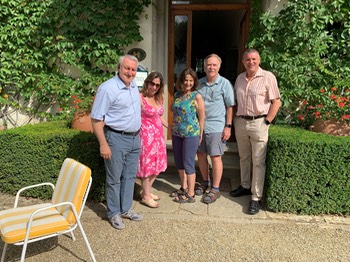
We packed up and left Villa le Barone and headed for Lucca. Our stay in Tuscany and the Villa was wonderful. Before leaving we took a group picture. From left to right: Ricardo our driver, Lynn, Caroline, Chuck, and Luciano our guide. Both Ricardo and Luciano were great.
We had a guided tour in Lucca with Linda. Lucca is built about 10 feet above the level of the Roman era city.
There is a wall that was built around the city. The first mention of the wall in any document was in 1513. It was mandatory for all the young men to work on constructing the wall. It was 30 feet wide to protect against cannon fire from Florence. Where the dirt was dug for the wall, they made a moat. Outside of the moat was a brick wall and another moat. Florence never attacked Lucca so the wall stayed in good shape.
At some point the wall was turned into a garden and park. It is a popular place to walk, bike, jog and just enjoy the beauty of the park. Below is a picture of the wall. On the left is where the moat would have been. Water form moat came from a nearby river. The edge of the wall runs down the middle of the picture. The wall extends another 20 feet to the right
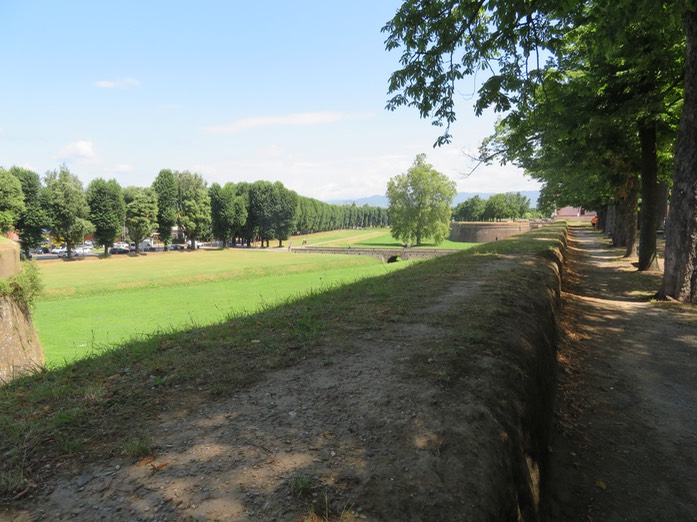

Lucca is built on a rectangular grid. The plan for streets was invented by Etruscans in 800 BCE.
On the right is a statue of Giamoco Puccini. He lived in Florence where he wrote his famous operas (Tosca, Madame Butterfly, La Boheme, and others). His father and grandfather were also composers writing mostly church music. His first opera (not well-known) was entitled Le Willy. It is based on a Germanic legend about evil female spirits would return from the dead to get revenge on the men who spurned them. Every summer a Puccini festival is held in Lucca.
Lucca has a concert series with Elton John and Sting (among others) performing this summer.
At one time Lucca had 124 churches. A powerful princess (Napoleon’s sister) decided to tear them down in order to decrease the power of the Catholic church and therefore increase her power. Thirty five churches remain with 10 still having services. We only visited three of them. Some pictures of the two major churches follow.

Saint Michael’s church.
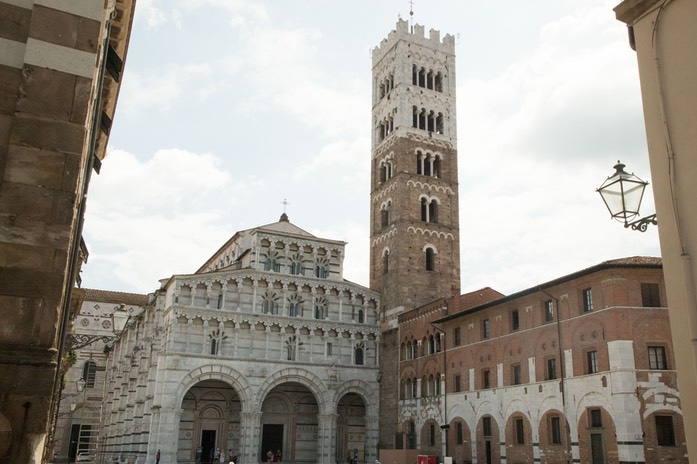
St. Martin’s Cathedral. A Cathedral is the seat of a Bishop.
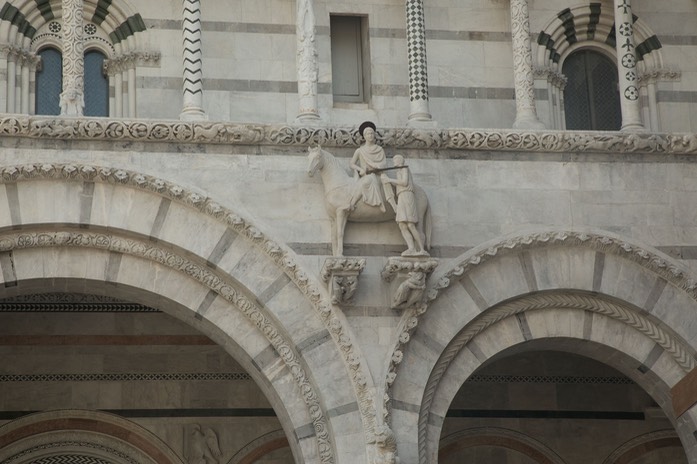
St. Martin is depicted on a horse because he was said to have been riding on the road when he came across a poor man freezing in the cold. He gave the man his cloak so he could become warm.
In the night his cloak came back to him.
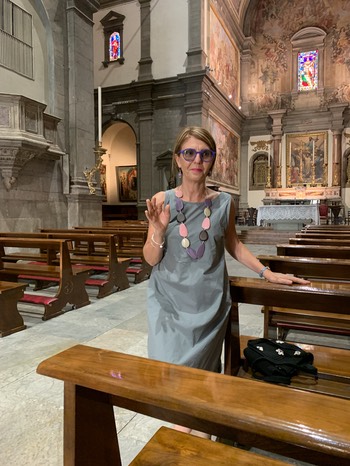
We went inside St. Martins where our guide, Linda (on the right) told us about the importance of relics for a church in early days. In order to be an important stop on the pilgrimage trail, a church needed to have a relic to signify its importance. Lucca had several relics including a container which was said to hold the blood of Christ.
There is also a crucifix which was said to have been carved by Nicodemus who was friendly to Jesus. In recent times, the crucifix has been dated to the 11th century. A picture of the crucifix is shown below.
In 2000, the pilgrim road was refurbished (brush was cleared form the trails and it became walkable again.) Once again, pilgrims are walking the trail to Rome.

The structure around the crucifix is to protect it.
Italy is famous for its marble. Our next stop was at a sculptor’s workshop. On the way we passed the mountains where the marble is quarried. In the picture below the white areas are marble. The marble in the mountains will last several millenniums. When we first saw the mountains we asked if it was snow. (typical question from Coloradans) In the old days the marble was quarried by inserting wooden wedges into the marble which expanded when watered. Eventually the marble would split. Getting it down off the mountain was difficult and dangerous undertaking. Today a long hole is drilled in the marble and a diamond encrusted wired is inserted and the hole which is then used to saw the marble.
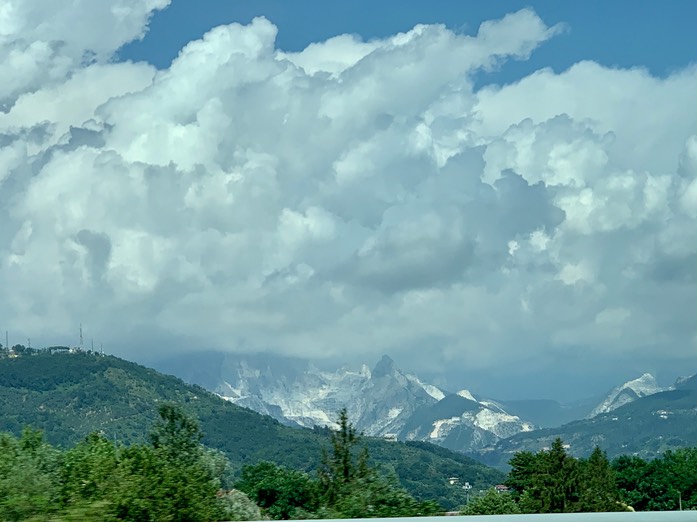
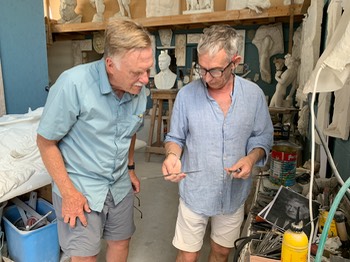
Our visit with the Sculptor Martin Foot was fascinating. Martin was born in Liverpool, England but has been living in Italy for over 20 years. On the right he is showing Chuck some of the tools he uses to sculpt the marble.
Behind Chuck you can see a part of the plaster cast for a major piece he has been working on for nearly a year. It is a sarcophagus for an English Lord who is having it built for his grave. He did not want us to take pictures since the Lord is still alive and the piece is not finished. The piece is full sized
The process starts with a small model in a clay which the client approves with changes.Then a full size clay model is made. When that is approved, a mold of it is made and a plaster model is made. The clay model is not used because it cracks and changes size as it ages. Plaster is stable and last a long time.
An oversized block of marble is set in place and roughed out with pneumatic tools to an inch or so of the final product. One reason to do that is to look for flaws in the marble. If flaws were found later in the process, much work might be wasted. Reference points are made in the plaster and the replicated on the roughed marble. Then the necessary depth on the final product can be determined very precisely. Martin moves from top to bottom several times coming closer to the finished procduct each time. When we saw the sarcophagus, it was nearly done with a few weeks of work left. It is an incredible work.
Here are some photos of his work.
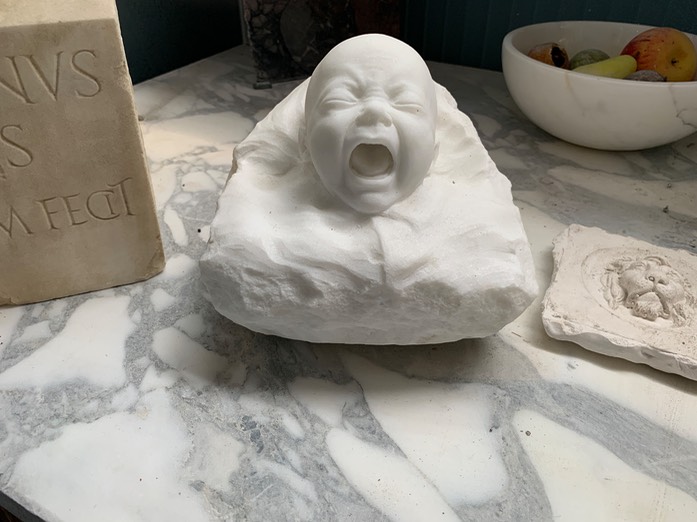
The crying baby rocks back and forth.

This is a smaller version of a larger sculpture. The expression on the man and on the dog is extraordinary.

Martin described this as a typical Italian woman. Again a wonderful expression on her face.

We saw these lips on a shelf. Martin told us that they were replicas of the lips of Michelangelo's David. We were admiring them and he said to take them. Caroline and Lynn each got a set.
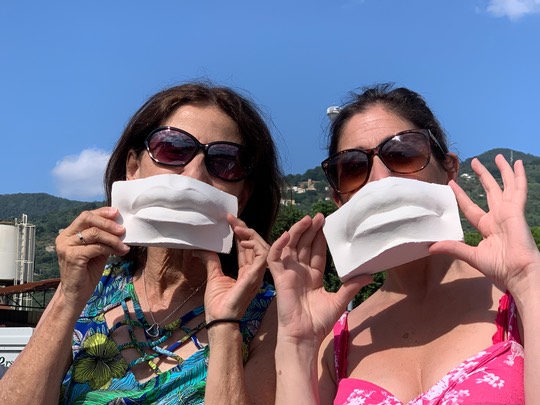
No words are needed to describe this picture.
Our time with Martin was really interesting. We could have visited all of the locations we have been to on our own, but without Luciano as our guide we would have never been able to spend an hour with Martin. Definitely a highlight of our trip so far.
We ended our day on the Italian Rivera in Santa Margherita at beautiful and elegant hotel. Dinner was in the hotel restaurant.
